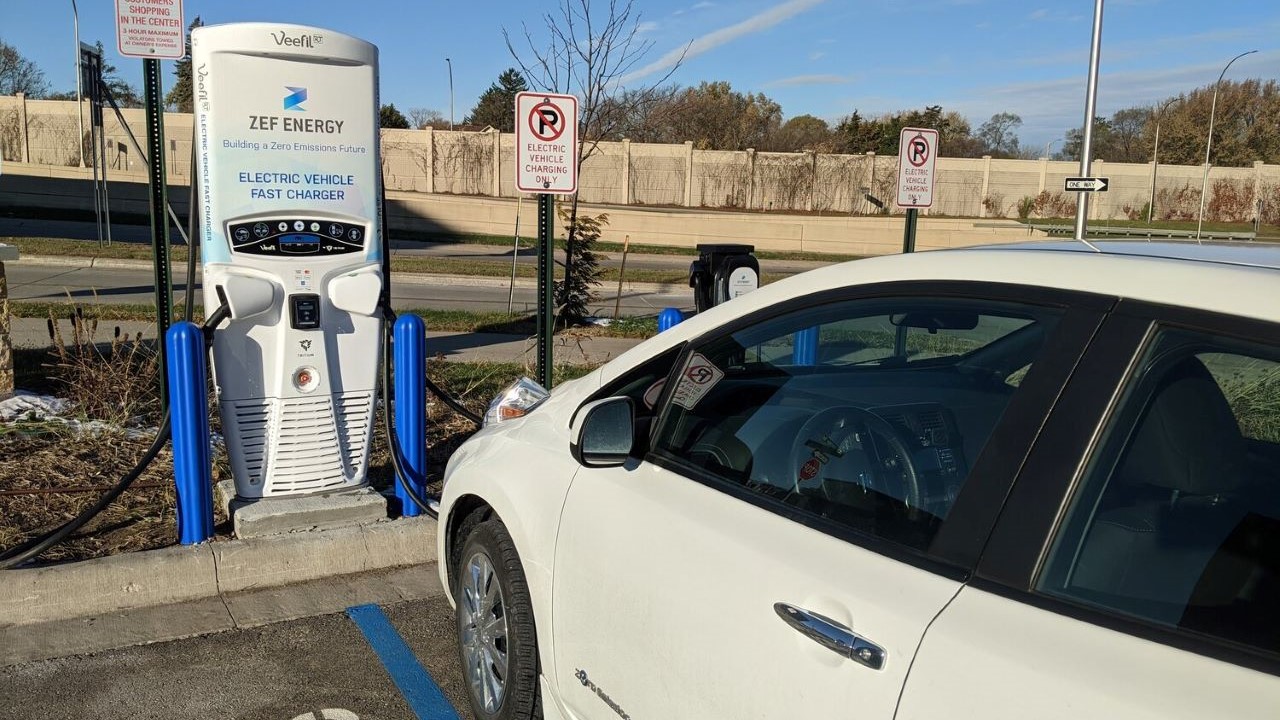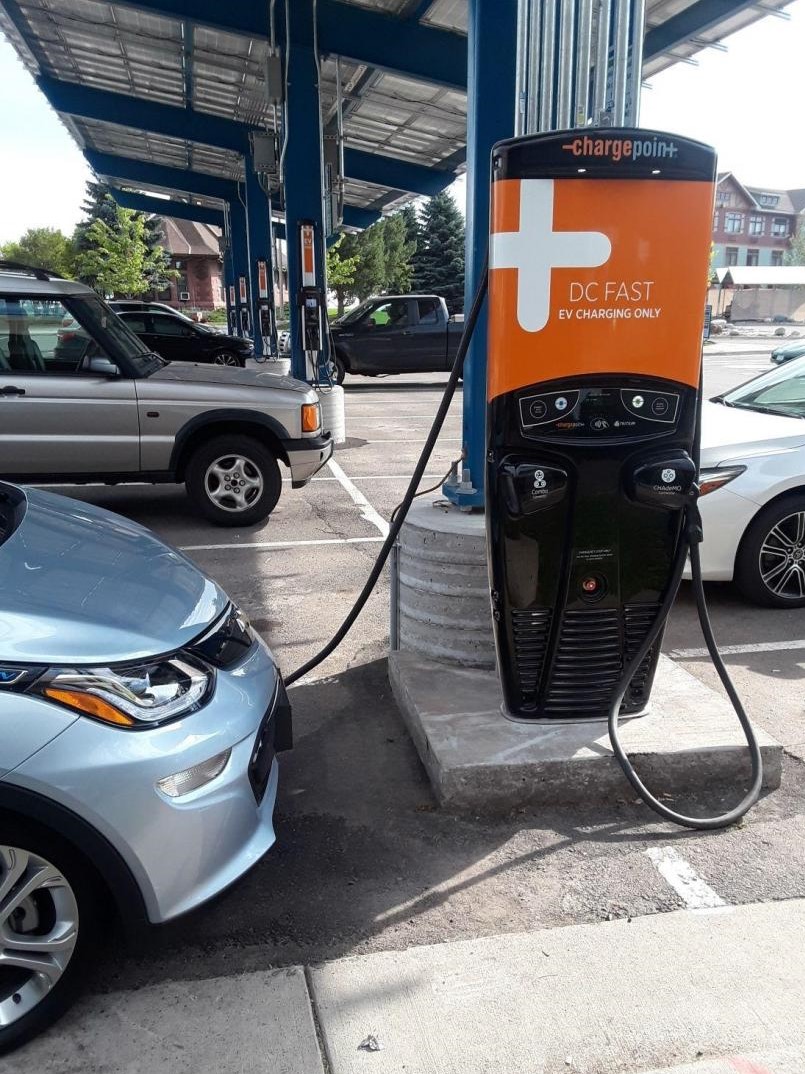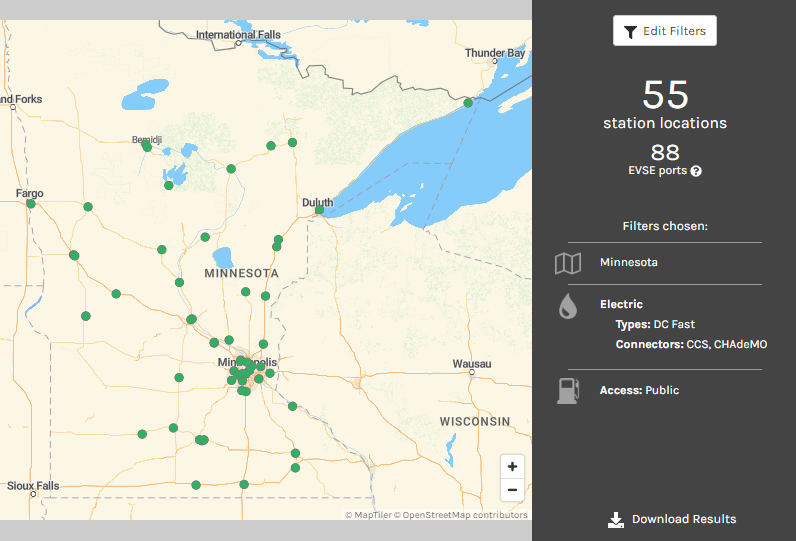
There’s been a huge push lately, both at the federal level and here in Minnesota, to amp up electric transit and transportation across the U.S. Fresh Energy’s Energy Transition program team is working at the forefront of this movement every day, driving decarbonization across Minnesota’s transportation, industry, and buildings sectors. As more and more details emerge around federal dollars going toward increasing accessibility of electric vehicle (EV) charging stations and charging networks throughout Minnesota, the Midwest, and the country as a whole, we thought it would be helpful to tackle the ins and outs of electric vehicle charging. Plug in with us below!
Types of EV charging
There are three main power levels of EV charging. Getting up to speed on these different types of charging is the first step to “level”-ing up your EV acumen.
- Level 1 charging
- Level 2 charging
- Direct Current Fast Charging (DCFC)
Level 1 charging is often also referred to as trickle charging. Level 1 charging uses a standard household 110-volt (V) outlet and will give an EV two to five miles of range per hour of charge. This type of charging is great when you can leave your car plugged in for an extended period of time, such as parking your EV at the airport while heading out of town for a trip or staying at a hotel for a few nights.
Next is Level 2 charging, which uses a 240V outlet, the type of outlet that your clothes dryer is plugged into at home. Level 2 charging gives an EV 10 to 40 miles of range per hour of charging, making it a great option for fleet, overnight charging, destination or “opportunity” charging (which we tackle in the next section!), and workplace charging.
Finally, there is what we call Direct Current Fast Charging (DCFC). DC Fast Charging stands out among the types of charging because it uses high voltage direct current electricity, rather than the alternating current we typically get in our homes. That means DC Fast Charging can deliver 200-400 miles of range per hour of charging, making it an exceptional option for traffic corridors, on-route charging, electric bus charging, and battery electric heavy-duty truck charging.
How are the different types of charging used?
Now that we’re on the same page about the types of charging, let’s dive into how charging is used. There are three charging use cases that we think about when building public EV charging:
- Residential charging
- Workplace charging
- Opportunity or destination charging
Residential charging, or charging at or near your home, is typically used overnight and is most often Level 1 or Level 2 charging. Many people are surprised to hear that a vast majority of EV charging is done at home overnight. This is likely due to ease of access (for those who can plug-in at home), money and time savings (residential electricity rates are typically much lower than the commercial electricity rates used for public charging), and, in many cases, it’s just more convenient! That means it is critical to ensure that there are chargers, including those open to the public, in multifamily housing units and single-family homes in densely populated areas, particularly for those that are rentals or those that don’t have garages or designated parking areas. It’s especially important to ensure access to Level 1 or 2 residential charging for under-resourced households, given that such charging is often much cheaper than DC Fast Charging.
For the remaining charging needed, people utilize both workplace charging and something called “opportunity” or destination charging. Workplace charging, as explained in its name, is typically used during the daytime on weekdays. Most often, workplace charging is fulfilled by Level 2 chargers.

Opportunity or destination charging refers to non-residential, non-workplace chargers. For example, a grocery store might have a Level 2 charger in the parking lot for shoppers to top off their battery while they pick up food for the week. Another example would be a state like Minnesota choosing to install DC Fast Charging corridors along interstates and other frequently travelled roads.
Although DC Fast Charging is responsible for a small percentage of most EV drivers’ charging needs, it still plays an integral role in the adoption and utilization of EVs, particularly to relieve range anxiety and provide required charging during longer trips. Currently, Minnesota has 55 public DC Fast Charging stations available for use, including nearly 30 DC Fast Charging stations scattered across cities and towns in Greater Minnesota!
What’s next for DC Fast Charging in Minnesota?
In order to ensure that EV drivers can regularly and reliably get to and through our state, and that more and more people regularly use and purchase EVs, we need to build out a robust, interconnected DC Fast Charging network that enables long distance electric vehicle travel. The good news is that this is happening as we speak! There are many projects underway across Minnesota to aid in the buildout of a robust EV charging network.
Utilities
All three investor-owned electric utilities in Minnesota—Otter Tail Power, Minnesota Power, and Xcel Energy—have recognized that they have a role in the deployment of DC Fast Charging and have each proposed and received approval from the Minnesota Public Utilities Commission for the development of fast charging networks in their respective service territories that help fill in the gaps left by private charging companies. Over the next several years, Otter Tail Power will build and install 11 DC Fast Charging stations, Minnesota Power will install 16 DC Fast Charging stations, and Xcel will install 21 DC Fast Charging stations.
Volkswagen settlement funds
Through Volkswagen settlement funding, the State of Minnesota has funded the purchase and installation of 22 DC Fast Chargers to date and plans to fund an additional 43 DC Fast Chargers through funding year 2023. These DC Fast Charging stations will lay the groundwork for a robust network of DC Fast Charging options throughout the state, enabling inter- and intra-state travel.

National Electric Vehicle Infrastructure (NEVI) funds
The State of Minnesota currently has the opportunity to leverage the single largest investment in EV infrastructure from the federal government to date through the National Electric Vehicle Infrastructure (NEVI) formula program, which was created by the Infrastructure Investment and Jobs Act (IIJA), commonly referred to here at Fresh Energy as the Bipartisan Infrastructure Law, passed in fall of 2021. The NEVI program will provide funding to states, territories, and tribes to support the deployment of EV charging stations primarily along interstate and highway corridors. The funding will come to the state through pre-apportioned “formula” funds provided to the Minnesota Department of Transportation (MnDOT). However, these funds may only be used to fund up to 80 percent of the cost of a charging station. That means MnDOT will have to provide the remaining 20 percent as a funding “match.” This funding match can come from the state itself or from private investments.
If the state does not put forward a 20 percent match and instead requires private investments to match funding, Fresh Energy and our partners have serious equity and access concerns about where these charging stations will be installed. Installation funded and led by the state would ensure that public charging does what it’s intended to do: serve the public. The purpose of publicly funded public charging is to fill gaps left by private charging companies, e.g., underbuilt areas where EV usage may not be quite high enough yet for private sector entities to build there profitably, but which still need EV charging to support EV adoption for those residents and ensure seamless travel across the state.
Fresh Energy believes that matching funds for NEVI, other IIJA programs, and similar funding programs should be provided by the state.
In the meantime, MnDOT is moving ahead with its NEVI planning, which is required to qualify for the formula funds. MnDOT has identified additional proposed Fast Charger locations along both I-94 and I-35 in Minnesota.
| Proposed DCFC along I-94 | Proposed DCFC along I-35 |
| Moorhead | Duluth |
| Fergus Falls | Moose Lake/Sturgeon Lake |
| Sauk Centre | Hinkley/Pine City |
| Alexandria | Forest Lake/Wyoming |
| St. Cloud | Burnsville |
| Maple Grove | Faribault |
| Minneapolis | Albert Lea |
| St. Paul |
Critical considerations as we expand EV charging
1. Equitable build out.
Communities of color as well as under-resourced communities disproportionately experience poorer air quality when compared to majority-white and middle-to-high income communities. This is in large part because many communities of color and under-resourced communities are located by industrial areas, freight corridors, and highway and interstate corridors as a result of the racist practice of redlining and the harmful buildout of the current interstate system. This exposes residents of these neighborhoods to a disproportionate amount of transportation sector emissions.
Exposure to these emissions reduces quality of life, increases the risk of developing respiratory diseases, and increases the occurrence of hospitalizations and mortality.
Not only do we need to ensure that we are not furthering or re-creating the impact of redlining when it comes to EV access, we also need to work to reduce the harm that has already been done. We can do this by designing programs and deploying investments with an equity-first lens, prioritizing the build out of EV infrastructure in both communities of color and under-resourced communities, and, most importantly, working with community representatives to co-develop projects that will truly serve their community’s transportation needs.
2. Installation, maintenance, and scalability.
As EVs and EV charging infrastructure are continuing to evolve, some publicly available DCFC stations are reported to be “down” or not operational, meaning they charge at far slower speeds than displayed, are broken upon arrival, are incorrectly advertised by operators, or fail to start a charge when plugged in. This can be from a variety of factors; flooding, trash accumulation in the area, and even software bugs can all disrupt service and leave EV drivers in a pickle.
It is critical to ensure drivers have a reliable network of chargers. It is also important to have a maintenance plan in place to ensure that the chargers themselves are working properly and that the area around the chargers is clean and clear.
As we are building out a network of fast chargers, it will be vital to ensure that each station can grow and evolve when new iterations of charging hit the market. This could look like laying the conduit for more chargers than are planned to initially be installed at a station, and/or ensuring the site has the right utility infrastructure for the predicted growth in demand of expanding or upgrading a DC Fast Charging site.
3. Seamless customer experience.
Currently, there are no national standards for the installation, operation, or maintenance of EV charging stations. Key components of the charging experience vary greatly between stations, e.g. operational practices, payment methods accepted, site design, display of price to charge at the point of sale, speed and power of chargers, and information about the availability and functionality of each charging station. As such, drivers don’t always know what to expect when they pull into a charging station.
Price to charge and payment methods accepted are two especially important variables that can impact the customer experience at a charging station. “Price to charge” refers to how the cost of a single charging session is calculated and displayed for a customer. Some charging stations might have a flat connection fee plus a dollar-per-kilowatt-hour fee structure, while others may have a flat fee for the entire charging session. Payment methods can also differ, with many charging stations only taking payment through the charging station company’s website or app or by calling the company and paying over the phone. Both types of variations make it challenging for drivers to estimate the cost of a charging session. As charging stations continue to get built out, it will be vital to offer many seamless, “open-access” payment options paying with a debit or credit card at the plug—and to display the price to charge consistently across charging stations so customers know what they’re paying for. For example, EV charging stations installed using federal transportation funding via the Bipartisan Infrastructure Law are required to have “open access…payment methods that are open to all members of the public to ensure secure, convenient, and equal access.”
4. Impact on the grid.
Finally, as we electrify more end uses in the economy, including the new demand from building out more EV chargers, it’s important to be cognizant of how to serve this new electric demand reliably and effectively and in a manner that optimizes carbon-free energy. Advances in grid modernization technologies thankfully can support such grid management, and electrification will spur and support innovation (like battery storage and other demand-response solutions) in this area.
As more and more EVs hit the road in Minnesota and across the U.S., it’s crucial that our public charging networks are ready to meet the demand and usher us into our electric future. Fresh Energy and our partners are actively working to advance policies and programs in Minnesota and beyond to ensure that EV charging is equitable, accessible, and reliable in our state so that it benefits all Minnesotans. Make sure you’re signed up for our monthly e-newsletter to get all updates sent your way!
